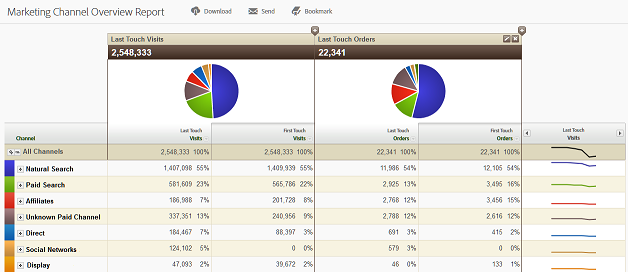
Marketing Channels Fundamentals
11 Sep 2016 » Analytics Tips
With this post, I am starting a mini-series on Adobe Analytics Marketing Channels. I will be explaining what they are, how to set them up and how to use them in your reports. A quick Google search shows a number of results, including the official documentation, but I want to give a more comprehensive view on them. In this first post, I will get into the fundamentals of Marketing Channels.
Why do you need them?
The main objective of the Marketing Channels reports is to show you how your visitors find your website. You might be asking yourself: “Wait a minute, doesn’t Adobe Analytics offer the traffic sources reports? Why do I need another set of reports for the same purpose?” In theory, you would be right. With the traffic sources reports you can see where the visitors are coming from. When web analytics started as a discipline, this was enough. However, over time, the requirements to track origins have been evolving and becoming more complex.
Medium to large corporations split the digital marketing budget across different activities or channels: SEO, paid search, paid media, sponsorships, affiliates, natural social, paid social… Even SEO and natural social require some funding, as you end up paying an SEO expert and a community manager. While spending this money, the organisation will want to know metrics like ROI and effectiveness for each channel. With this data, it is then possible to optimise the budget, in order to increase the revenue with the same budget, by prioritising channels with higher gains.
Simply using the traffic sources reports, it can be very difficult to tie visit to a marketing activity. For example, a referrer of google.com could be natural search, paid search, Google Maps… The solution is to allow for complex rules to be applied to a visit, to detect which channel the visitor came from. Following the previous example, if the referrer is google.com and there is a query string parameter named “gclid”, we can say it is paid search.
Evolution towards Marketing Channels
Adobe did not introduce the Marketing Channels reports, if I remember correctly, until SiteCatalyst v15. What was used before?
The first solution was a VISTA rule named Unified Sources. It applied rules to the first page view of a visit, combining referrer, URLs, eVar and whatever information that was available, to classify the visit by setting a number of eVars. It was initially a good solution, as it did not require any changes to the website. The main disadvantage was that you needed to contact Engineering Services every time you needed a change in the rules. This solution is not offered any more and only old implementations still use it.
A second solution, which offered much more flexibility, was Channel Manager. In this case, instead of being a server-side solution, the code was moved client-side. Now you had a piece of JavaScript, executing in the browser, populating the same eVars as Unified Sources. The rules were very similar, but now the marketers had more control over it. Changes to the rules just needed a new release of the JavaScript file or, if using a tag manager, a few clicks.
Finally, Adobe introduced the Marketing Channels reports. They combine the benefits from the two previous solutions and add others:
- Server-side execution. No need to add additional JavaScript to the client-side code.
- Easy configuration. You manage the rules via the the web interface.
- Dedicated variables. No eVars are used, which tends to be useful when you have a large implementation.
- New reports. The interface has dedicated reports for Marketing Channels.
- Cost tracking. Although I have never seen anybody using it, you can add the cost for each of the channels in your reports.
Processing flow
Last, but not least, of this introduction is the processing flow. I believe it is important to understand when the Marketing Channels process is executed.

This order of execution has some consequences, which will be clearer in the next post.